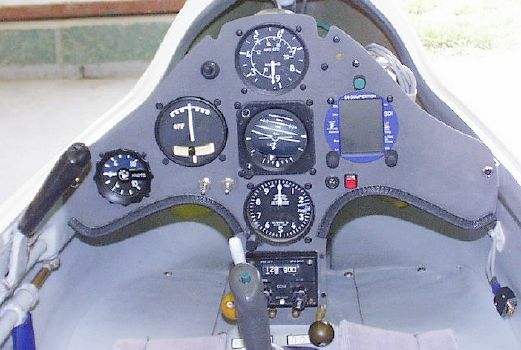

At the end of the 2003 season I looked at my flying costs, did some sums and decided that I could save money without sacrificing any fun if I owned a glider in the same general performance and cost band to FVV. As a result I bought 123 in late February, 2004. 123 is an ASW-20, serial number 34, built in 1977. When I bought it in February, 2004, it was equipped with a well-fitted out panel:
 |
|
The ASW-20, designed by Gerhard Waibel, is the 20th type built by Alexander Schleicher of Poppenhausen, Germany. Poppenhausen is situated at the base of the Wasserkuppe, the site of the world's first sport gliding competition in 1920. Alexander Schleicher's business was founded in 1927 and is the worlds oldest glider manufacturer, having been in business continuously since its beginnings. I visited the Wasserkuppe in 2002 and 2003. The first visit saw cloud down over the top of the 1060m hill, a not uncommon situation. I was able to fly over the beautiful countryside on my second visit: appropriately I flew Schleicher gliders: a check ride in an ASK-21 followed by a flight in an ASK-23 single seat club type.
The ASW-20 first flew in 1977 and was an instant success, winning numerous world and national championships. Built to the 15 m. racing class specification, it features trailing edge flaps which interconnect with the ailerons and allow the entire trailing edge to operate as a flap between -9 and +8 degrees during normal flight. The flaps also act as ailerons, but deflect only half as far as the ailerons. In landing configuration the flaps are set to +55 degrees while the ailerons reflex to -8 degrees to prevent tip stalling and increase roll control below flying speed. This model has a further flap position, known as the "Jesus Flap", for short approaches. The flaps descend a further 20 degrees while the ailerons stay at -8 degrees. This setting adds drag without affecting lift: as a result the approach path becomes extremely steep. Schlempp-Hirth type airbrakes are provided on the upper wing surface only and are used in conjunction with the flaps for landing. The fuselage is similar to that of the ASW-19.
There are several later variants on the design of the ASW-20, with about 1000 examples being built in total. The B and C model differ in having:
The important differences are in the safety aspects of the fuselage. All models exist also as a "L" version with 16.6m span of which only the BL may carry water in the 16.6m version.
Centraire built the original version under license in France as the ASW-20F. They also made a 16.6m ASW-20FL version.
The glider is nicely balanced, with well-harmonised controls during normal flight. Its stalling and spinning behaviour is benign: if it does depart it is important to put the flaps negative to avoid exceeding Vne, but this action alone will often stop rotation and recover from the spin. There is a different Vne for each flap setting: Vne increases as the flap angle reduces. There is remarkably little attitude change with airspeed. If trimmed hands-off at 50 knots a phugoid oscillation develops in calm air. This has a period of 20 seconds and an airspeed swing of +/- 5 kts. It takes two or three cycles to develop and then stabilizes at a constant period and amplitude.
| Specifications | Performance | ||
|---|---|---|---|
| Wingspan: | 15 m | L/D max: | 41.7 @ 57 kts |
| Length: | 5.82 m | Min. Sink | 0.56 m/s @ 40 kts |
| Height: | 1.45 m | Vne: | 143 kts |
| Wing area: | 10.5 m^2 | Stall: | 36.4 kts |
| Aspect ratio: | 21.43 | ||
| Wing section: | FX62-K-131 mod. / FX60-126 | ||
| Empty weight: | 255 kg | ||
| Payload: | 199 kg | ||
| Gross weight: | 454 kg | ||
| Wing loading: | 32 - 43 kg/m^2 | ||
| Water ballast: | 120 kg |
Unfortunately, I managed to write 123 off during the Gransden Regionals in 2004 during an attempted field landing. Nobody knows exactly what happened: I don't remember the flight at all and there were no witnesses. All I know is that the logger shows I'd come 14 miles since my last climb, had a final low level scratch for lift and headed for a field that I must have previously picked. Then I made a downwind approach that went wrong and ended up in a ditch under a hedge. My best guess is that I lost wind orientation while scratching for lift and then ran into an adverse wind gradient low on finals. Fortunately, a gaggle of club mates came over two or three minutes later and spotted the wreck. Neil Gaudie landed while Mike Roberts called in the Mayday. Thanks to them I'm still here to tell the tale.
I've kept the trigraph, so 123 will fly again along with the logger, GPS and final glide computer.